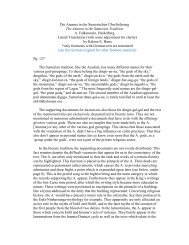5. Sitchin's contention that "Adam was the first test ... - Sitchin Is Wrong
5. Sitchin's contention that "Adam was the first test ... - Sitchin Is Wrong
5. Sitchin's contention that "Adam was the first test ... - Sitchin Is Wrong
Create successful ePaper yourself
Turn your PDF publications into a flip-book with our unique Google optimized e-Paper software.
5<br />
B. As noted above, elsewhere on page 161 of Genesis Revisited, <strong>Sitchin</strong><br />
(correctly) notes <strong>that</strong> <strong>the</strong> word for "man" is not "<strong>Adam</strong>u," but LU<br />
(Sumerian) and awilu (Akkadian). Awilu can mean "slave" or "laborer,"<br />
and so <strong><strong>Sitchin</strong>'s</strong> translation "primitive worker" (when rendering awilu,<br />
not adammu) is legitimate. Never<strong>the</strong>less, it is obvious <strong>Sitchin</strong> wants to<br />
connect "<strong>Adam</strong>u" (and so, <strong>Adam</strong>) with "primitive worker."<br />
Comments:<br />
The goal of this false equation is to lead <strong>the</strong> reader to <strong>the</strong> idea<br />
<strong>that</strong> <strong>the</strong> biblical word "<strong>Adam</strong>" also has <strong>the</strong> meaning "primitive<br />
worker" or "slave" of <strong>the</strong> gods, and so convince <strong>the</strong> reader <strong>that</strong><br />
<strong>the</strong> Hebrew Bible actually has <strong>Adam</strong> being created for <strong>the</strong> same<br />
reasons as <strong>the</strong> Sumero-Akkadian story. This is turn shows<br />
literary dependence (as opposed to a common core religious<br />
belief in <strong>the</strong> ANE) in <strong>the</strong> minds of <strong><strong>Sitchin</strong>'s</strong> readers. Nei<strong>the</strong>r idea<br />
is accurate. The Hebrew Bible has no indication <strong>that</strong> humans<br />
were designed to be slaves for <strong>the</strong> gods (in fact, before <strong>the</strong> Fall in<br />
Genesis 3, <strong>the</strong>ir work <strong>was</strong> without hardship of any kind). The<br />
Hebrew Bible's independent articulation of <strong>the</strong> common ANE<br />
idea <strong>that</strong> humanity <strong>was</strong> supernaturally created is shown by (1)<br />
<strong>the</strong> ABSENCE of <strong>the</strong> slave motif; (2) <strong>the</strong> incorporation of o<strong>the</strong>r<br />
ANE ideas (cf. Egyptian and Ugaritic) not found in <strong>the</strong> Sumero-<br />
Akkadian versions; (3) completely innovative and unique<br />
elements in <strong>the</strong> story.<br />
C. <strong><strong>Sitchin</strong>'s</strong> "<strong>Adam</strong>u" <strong>was</strong> allegedly made from an already existing<br />
hominid, upon whom <strong>was</strong> placed <strong>the</strong> divine "image" (cf. p. 160, Genesis<br />
Revisited). <strong>Sitchin</strong> fur<strong>the</strong>r states <strong>that</strong>, "<strong>the</strong> term 'image' in <strong>the</strong> Sumerian<br />
text is repeated intact in <strong>the</strong> biblical text."<br />
Comments:<br />
1. There is no reference to <strong>the</strong> divine "image" in <strong>the</strong> Sumerian<br />
and Akkadian texts. This is a totally contrived and agendadriven<br />
"translation."<br />
2. Even if <strong>the</strong> word "image" WAS in <strong>the</strong>se texts, <strong>the</strong><br />
interpretation of humanity beign derived from a genetically<br />
"upgraded" hominid depends on <strong><strong>Sitchin</strong>'s</strong> translations of key<br />
terms in <strong>the</strong> description of <strong>the</strong> creation of humanity.<br />
file:///C|/My%20Documents/MSH/HTMLExpoFiles/adamstuff.htm (4 of 7) [9/9/01 12:08:57 AM]




